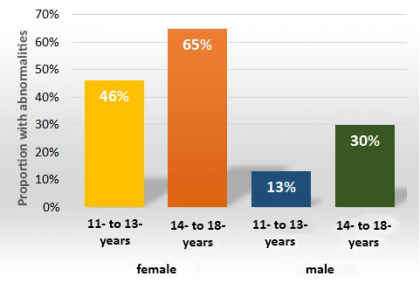In July 2021, we conducted a survey among children and adolescents –aged 11 to 17 years old– of DigiHero’s registered participants. The focal points were the special stresses that this particular age group had to endure during the pandemic.
Of all the children and youths who took part in the survey, around 70% stated to have a high standard of living. However, the survey revealed potential indications of mood abnormalities among the younger population: more than 40% of participants showed a notable tendency toward symptoms of depression in their data¹. These anonmalies occurred more frequently in adolescents (between 14–18 years old) than in older children (between 11–13 years old). Overall, more girls than boys reported symptoms of depression (Fig. 1).
Above all, the leisure and mobility restrictions were experienced by the children and adolescents to be the greatest burden weighing on them. Contact restrictions followed as the second most frequently mentioned impact on their lives, followed by the education from home. Nevertheless, there were also reports of positive consequences of the pandemic: some participants had a positive perception of one particular side effect of required work and studies from home. Namely, being able to spend more time with their families. Furthermore, some participants also reported that measures such as studying from home helped them to develop a sense of independence.
¹measured using the General Depression Scale for Children and Adolescents (Center for Epidemiological Studies; Depression Scale for Children, CES-DC)
